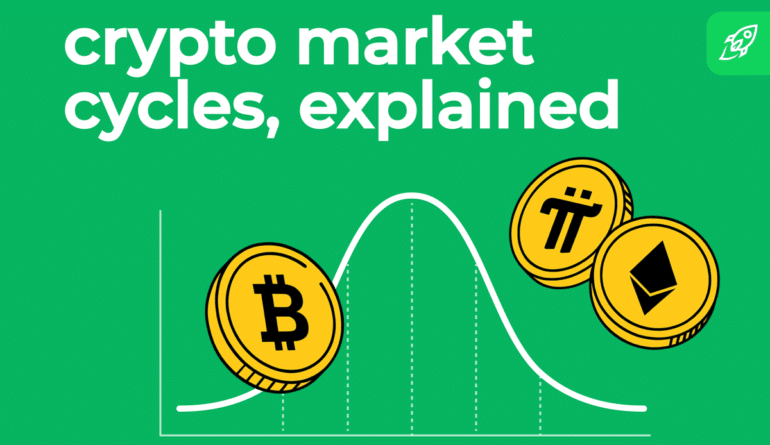Crypto Market Cycles: A Simple Guide for Beginner Traders
Notorious crypto volatility feels random. But that’s until you see the pattern. The theory of crypto market cycles reveals why prices lurch from euphoria to despair.
This guide maps out the phases that repeat again and again, giving you a smarter framework for when to buy, hold, or exit.
What Are Market Cycles?
Crypto market cycles refer to the repeating phases of growth and decline in asset prices.
In the crypto market, these cycles are often sharp and fast, but the pattern remains the same. Assets experience rising prices, then corrections, then repeat.
These cycles are largely driven by changes in investor behavior. Waves of optimism and buying push prices up, then fear and selling bring them down. For example, in a bullish swing everyone’s excited and piling in, whereas in a downturn the same crowd turns fearful and pulls back. Learning to recognize these phases helps you prepare instead of just reacting.

How Crypto Cycles Differ from Traditional Market Cycles
All markets go through periodic fluctuations, but the cryptocurrency market moves faster and hits harder than most.
In traditional assets like stocks or real estate, a full rise and fall might take years. In crypto, it can happen in months.
Why? Crypto is a newer, more volatile asset class with 24/7 trading, global access, and fewer regulations. That makes prices more sensitive to news, hype, and emotion. A tweet, a hack, or a policy change can shift momentum instantly. While the cycle pattern is the same, crypto cycles are more extreme, offering bigger opportunities, but also greater risk.

Crypto Market Cycle Phases
A typical crypto market cycle has four phases. Let’s break down each phase and its characteristics.
Phase 1: Accumulation
During the accumulation phase, prices are low and mostly stable. The crash is over, but interest is still low, and trading volumes stay low too. Any upward price movements are gradual and cautious. Market dynamics feel flat, but that’s the point, since this phase builds the foundation for the next trend.
Often, this phase can coincide with stabilization in the broader economy. For instance, if interest rates are low, risky assets like crypto become a bit more attractive again. This is when smart money starts buying quietly, while most retail investors are still skeptical. Institutional investors often buy slowly to get a low average price. In short, the market is quietly healing during accumulation, even though most people don’t notice it.
Phase 2: Uptrend (Bull Market)
Next comes the uptrend, aka the bull market everyone loves.
In this phase, prices rise quickly. Positive news, new projects, and technological developments fuel growth.
Bitcoin often leads the rally, rising faster and earlier than most altcoins. Historically, BTC has seen parabolic gains during this phase—for example, rising from ~$3,000 to ~$20,000 in 2017, and from ~$10,000 to over $60,000 in 2020–2021.
Investor sentiment flips from fear to optimism, and more retail investors enter the market. As trading volume surges, digital assets get more attention in media and social spaces. Everyone wants in. With each price breakout, investor confidence grows. During a strong bull run, sentiment can even turn euphoric. But no market keeps rising forever.
Phase 3: Distribution
As prices peak, early investors begin taking profits. This is the distribution phase, where smart money exits and latecomers buy in.
The market feels uncertain—some days are green, others red. There’s no clear trend. Yet more investors keep entering, chasing past gains and thinking prices will resume climbing. Volume stays high, but momentum slows. Many traders mistake this for a temporary pause, not realizing the top is forming. This quiet shift often goes unnoticed until it’s too late.
Phase 4: Downtrend (Bear Market)
Downtrends in crypto always hit hard. Prices fall fast, and market participants rush to exit. Crypto assets lose value across the board, triggering panic selling. As investors sell at a loss, emotions shift from denial to fear. Negative news dominates headlines, feeding negative sentiment. This capitulation phase can feel endless; confidence is shattered and it’s hard to imagine prices turning up again.
But for long-term thinkers, it’s when they buy more. Beneath the fear, the next cycle begins quietly. Then, the stage is set for a return to accumulation.
The Psychology Behind Market Cycles
Markets move in cycles because emotions get there first. Greed, fear, and hope drive market movements more than logic.
In bull runs, optimism turns into euphoria. In crashes, that flips to panic and despair. Prices tend to swing beyond fair value in both directions because of this emotional behavior. Being aware of these psychological patterns can make you a better trader.

Institutional investors often buy when everyone else is scared and sell into strength. When others are overconfident, stay cautious. When fear peaks, look for opportunity. Once prices stabilize and emotions cool, the cycle resets. Understanding this psychology helps shape better investment strategies that are less reactive and more prepared. If you know what others are feeling, you can act differently, and that’s often where profits are made.
How to Identify a Crypto Market Cycle
To spot a market cycle, start with price trends.
Are prices rising steadily or falling sharply? In a bull phase, you’ll see higher highs and strong momentum. In a bear phase, lower lows and weak rallies dominate. Next, look at market sentiment. Is the mood greedy or fearful? When people brag about profits, it might be time to be cautious. When silence or despair takes over, a bottom may be near.
Watch participation.
If many investors are suddenly entering the market—especially those who don’t usually follow crypto—it could be a late-stage bull. Volume spikes can confirm momentum shifts in either direction.
Finally, check macro conditions.
Rising interest rates often signal tighter money, which hurts high-risk assets like crypto. On the other hand, low or falling rates can help fuel rallies. No single signal gives you the perfect answer, but combining trend, sentiment, participation, and macro clues can help you spot the cycle stage.
Historical Market Cycles in Crypto
Looking at historical data helps you understand how crypto cycles unfold. Let’s look at a couple of famous examples.
2017 Boom & 2018 Crash
Bitcoin started the year near $1,000 and soared to almost $20,000 by December—a classic bull phase driven by retail FOMO (fear of missing out) and the ICO boom. But in early 2018, the market collapsed. Bitcoin lost over 80% of its value, and altcoins dropped even harder. This crash triggered what became known as the “crypto winter.”
2020–2021 Bull & 2022 Downturn
After the COVID-19 dip and a quieter period, the market surged. Bitcoin hit a record $69,000 in November 2021, fueled by institutional adoption, NFTs, and easy-money policies. Then came 2022. As macroeconomic factors shifted—rising inflation and interest rates—crypto prices tumbled. The crypto market entered a harsh bear phase: Bitcoin crashed below $20,000, erasing a lot of its gains. High-profile failures like Terra and FTX added panic to the mix. Once again, the market lost over half its value.
Each cycle looks different on the surface, but the pattern stays the same: accumulation, breakout, mania, decline, recovery. Past performance doesn’t guarantee the future, but these cycles repeat because human fear and greed (and external triggers) drive price action.
The Role of Bitcoin Halving in Market Cycles
Every four years, the Bitcoin network goes through a “halving”—a major supply cut that reduces mining rewards by 50%. These halvings have historically been a catalyst for major crypto cycles. After each halving in 2012, 2016, and 2020, prices surged within 12–18 months. Why? Reduced supply creates scarcity, and demand often follows.
Savvy investors watch these events closely. Many begin accumulating before the halving, expecting higher prices down the line. It’s not guaranteed, but history shows a strong pattern of post-halving rallies.
Continue reading: Is the Bitcoin Halving Effect on the Altcoin Market Real?
Still, timing depends on more than just supply. The global economy matters too. If interest rates are rising or markets are under stress, crypto gains may be slower or short-lived. But if conditions are favorable, a halving can help trigger or extend a bull run. Halvings don’t create demand, but they do limit new supply, setting the stage for price growth when buyers return.
Strategies for Each Phase
Each part of the cycle calls for a different approach.
- In the accumulation phase, focus on research and long-term crypto trading. Prices are low and quiet, so this is the time to build positions in strong projects. Buying slowly helps you get a better average and avoid guessing the bottom.
- During the uptrend phase, things heat up. Crypto prices rise, and more new investors enter the market. Stick to your plan. Take profits at key levels instead of chasing peaks. Use risk management tools like stop-losses to protect your gains. High emotion and high trading volume can cloud judgment—don’t get swept up in it.
- In the distribution phase, shift to defense. If you’ve made solid returns, start locking in profits. Watch for signs of slowing momentum and lower highs.
- In a bear market, the goal is survival. Don’t panic-sell unless your thesis changes. Reduce exposure if needed. Use the time to reflect, learn, and rebalance. If you believe in the project, it can also be a time to slowly accumulate again. Just move cautiously.
No matter the phase, discipline beats emotion. Stick to your plan, manage risk, and never invest more than you can afford to lose.
Common Mistakes to Avoid
Even experienced crypto traders make costly mistakes during market cycles. One of the biggest? Emotional trading. Fear and greed often lead to buying too late and selling too early. FOMO kicks in as prices begin to rise, and panic selling hits when markets drop. Instead, have a plan and stick to it.
Another mistake is ignoring the outside world. Macroeconomic factors—like inflation, interest rates, or regulation—can flip the market fast. Don’t just watch charts; track the bigger picture too.
Many traders also chase hype without research. Just because everyone’s buying doesn’t mean it’s a smart move. Hype-driven decisions often backfire when momentum fades.
Lastly, don’t overlook risk. New coins, leverage, and overexposure can create uncertainty in your portfolio. Always size positions carefully and expect volatility. Avoiding these traps won’t guarantee profits, but it will help you protect capital—and that’s what keeps you in the game long enough to win.
Read More: Risk Management in Crypto
Final Thoughts
Crypto markets might seem chaotic day-to-day, but they often follow a cyclical pattern. By studying these patterns, you can approach trading with a cooler head and make more informed investment decisions. And instead of chasing every hype wave or panicking at every dip, you can recognize which phase the market is in and adjust accordingly.
FAQ
How long do crypto cycles last?
Crypto cycles move faster than those in traditional financial markets. A full cycle—from accumulation to a new peak and back—typically lasts 2 to 4 years. This often lines up with Bitcoin cycles, especially the four-year halving schedule.
However, smaller cycles can unfold in months during volatile periods.
Can altcoins have independent market cycles from Bitcoin?
Yes, they can and they do. But still, they mostly follow Bitcoin’s lead.
Major Bitcoin moves—up or down—usually affect the whole market. But sometimes altcoins move on their own, especially during “alt seasons.” When Bitcoin dominance on the market is high, capital flows mostly into BTC. When it falls, money often rotates into altcoins. That’s when prices start to climb for smaller tokens, even if Bitcoin stays flat.
How do I know which phase the market is currently in?
No single metric tells you everything. Check market conditions first. Are prices trending up or down? Use technical analysis tools like moving averages and volume to confirm this direction. Watch sentiment: greed often signals a top, fear a bottom. When price action, sentiment, and indicators align, you can usually spot the phase with more confidence.
Disclaimer: Please note that the contents of this article are not financial or investing advice. The information provided in this article is the author’s opinion only and should not be considered as offering trading or investing recommendations. We do not make any warranties about the completeness, reliability and accuracy of this information. The cryptocurrency market suffers from high volatility and occasional arbitrary movements. Any investor, trader, or regular crypto users should research multiple viewpoints and be familiar with all local regulations before committing to an investment.
The post Crypto Market Cycles: A Simple Guide for Beginner Traders appeared first on Cryptocurrency News & Trading Tips – Crypto Blog by Changelly.
Cryptocurrency News & Trading Tips – Crypto Blog by Changelly



















